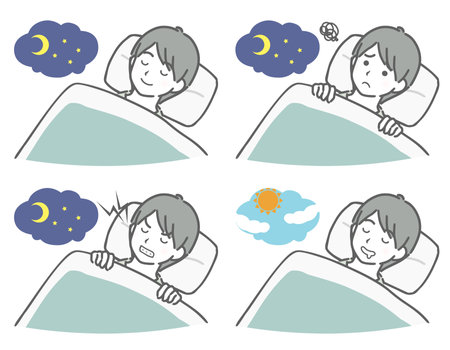Understanding Co-Sleeping and Independent Sleep
When it comes to bedtime routines for young children, two popular approaches often come into play: co-sleeping and independent sleep. In the United States, these practices can spark a lot of discussion among parents, pediatricians, and parenting communities. Co-sleeping typically refers to a child sharing the same sleeping space as their parent or parents—this might mean bed-sharing or room-sharing, where a child sleeps in the same room but on a different surface, like a crib or bassinet. Many families choose co-sleeping for reasons such as bonding, breastfeeding convenience, or simply cultural tradition.
On the other hand, independent sleep involves a child sleeping on their own, either in a separate crib, toddler bed, or even in their own bedroom. This method is often encouraged in American culture as it’s associated with promoting self-soothing skills and independence from an early age.
Both approaches are shaped by family values, safety recommendations from organizations like the American Academy of Pediatrics (AAP), and practical considerations like available space and parental work schedules. Understanding these foundational definitions is the first step in making an informed decision about what works best for your family’s unique needs.
Pros of Co-Sleeping
Co-sleeping, or sharing a sleeping space with your child, is a topic that sparks plenty of conversation in American parenting circles. While every family is unique, co-sleeping offers several potential benefits for both children and parents, especially when viewed through an emotional, developmental, and practical lens. Let’s explore how co-sleeping can be a positive experience within the context of American culture.
Emotional Benefits
One of the standout advantages of co-sleeping is the emotional connection it fosters. Children who sleep close to their parents often feel more secure and comforted throughout the night. This closeness can reduce nighttime anxiety, help little ones fall asleep faster, and even lead to fewer nighttime awakenings. For parents, there’s often a sense of reassurance knowing they are nearby if their child needs them.
Developmental Benefits
Research suggests that co-sleeping may support healthy attachment and emotional development. Young children thrive on physical closeness, especially during their early years. Being close to a parent at night can encourage trust, strengthen the parent-child bond, and promote self-confidence as children grow older.
Key Developmental Advantages Table
| Benefit | Description |
|---|---|
| Attachment Security | Promotes strong parent-child bonding and trust |
| Reduced Separation Anxiety | Helps children feel safe and less anxious at night |
| Emotional Regulation | Supports children in learning to manage emotions with parental presence |
| Confidence Building | Lays the groundwork for future independence by meeting current needs |
Practical Benefits for American Families
Beyond emotional and developmental gains, co-sleeping can make life easier—especially for new parents juggling busy schedules. Nighttime feedings become simpler when your baby is nearby, which can lead to better sleep for everyone. Many American parents also find that co-sleeping saves time during late-night comforting or diaper changes. In households where both parents work or have hectic routines, this extra convenience can be a game-changer.
Summary: Why Some American Parents Choose Co-Sleeping
- Easier Nighttime Care: Quick response to feeding or comforting needs.
- Cultural Flexibility: Fits diverse family structures and living arrangements common in the U.S.
- Enhanced Sleep Quality: May result in better sleep for both kids and adults.
- Strong Family Bonds: Fosters daily opportunities for connection despite busy lifestyles.
While co-sleeping isn’t right for every family, understanding its potential pros helps parents make informed decisions tailored to their values and circumstances within the American context.
![]()
3. Cons of Co-Sleeping
While co-sleeping may offer comfort and bonding opportunities, it’s important to consider the potential downsides as well. One of the biggest concerns is safety. The American Academy of Pediatrics (AAP) has warned about the increased risk of Sudden Infant Death Syndrome (SIDS) and accidental suffocation when babies share an adult bed, especially if parents are deep sleepers or use soft bedding, pillows, or heavy blankets. Even though many families practice safe co-sleeping with precautions, these risks can’t be ignored.
Another challenge is the impact on sleep quality—for both parents and children. Sharing a bed can lead to more frequent night wakings due to movement or noise. Parents might find themselves sleeping in awkward positions or waking up throughout the night to check on their child, leading to chronic sleep deprivation. Over time, this can affect mood, energy levels, and even relationships within the family.
Co-sleeping can also make it harder for children to develop independent sleep habits. Kids who are used to having a parent close by may struggle with separation anxiety or have difficulty falling asleep on their own when it’s time to transition to their own bed. This can turn bedtime into a nightly power struggle and make sleepovers or travel more stressful for everyone involved.
Finally, privacy can become an issue for parents who co-sleep long-term. Having a child in the bed may limit opportunities for intimacy or quiet time as a couple, which is important for maintaining a healthy relationship.
4. Pros of Independent Sleep
Encouraging independent sleep comes with a host of benefits for both children and parents. When children learn to fall asleep on their own, they begin to develop essential self-soothing skills that will serve them throughout their lives. This process not only fosters confidence and resilience but also helps kids understand healthy boundaries within the family structure—a key part of growing up in American culture, where independence is highly valued.
Building Self-Soothing Skills
One of the biggest advantages of independent sleep is that it gives children the chance to practice calming themselves when they wake during the night. Instead of relying on a parent’s presence, they learn techniques like cuddling with a favorite stuffed animal or quietly humming to themselves. Over time, these self-soothing abilities lead to better sleep quality and longer stretches of rest for both kids and parents.
Promoting Healthy Boundaries
Independent sleep also supports the development of healthy boundaries within the family. Having their own sleep space teaches children about personal privacy and respect for others’ space—important lessons that align well with American values of autonomy and personal responsibility. This separation at bedtime can make reunions in the morning even sweeter, reinforcing positive family connections.
Quick Comparison: Benefits of Independent Sleep
| Benefit | Description |
|---|---|
| Self-Soothing Skills | Children learn to calm themselves and manage minor nighttime disturbances independently. |
| Consistent Routines | Establishing set bedtimes and routines encourages better sleep habits. |
| Healthy Boundaries | Keeps clear distinctions between adult and child spaces, promoting mutual respect. |
| Parental Rest | Parents are more likely to enjoy uninterrupted sleep, supporting their own well-being. |
| Lifelong Confidence | Kids gain a sense of accomplishment by mastering sleep on their own. |
Level Up: A Growth Mindset Approach
Think of independent sleep as an achievement unlocked in your childs development journey. With each night spent sleeping solo, your child builds up “XP” (experience points) in self-reliance, emotional regulation, and confidence—key traits for success both in school and beyond. Supporting this transition isn’t always easy, but remember: every small step counts toward leveling up your family’s sleep skills!
5. Cons of Independent Sleep
While independent sleep can foster important life skills for children, it doesn’t come without its own set of challenges. Many American families discover that the transition from co-sleeping to independent sleep is not always smooth sailing. One of the most common hurdles is separation anxiety. Especially in younger children, sleeping alone can trigger feelings of fear or loneliness, leading to bedtime resistance and nighttime awakenings. This adjustment period can be tough on both kids and parents, as everyone adapts to new routines and expectations.
Another challenge is the emotional toll on parents who may feel guilty or worried about their child’s comfort and security. Cultural messages in the U.S. often emphasize self-reliance, but every family has its unique rhythm, and some children may simply take longer to adjust. Additionally, logistical issues—like siblings sharing rooms or space limitations—can complicate the process.
Families might also face disrupted sleep schedules during the transition phase. Children who are used to close physical contact at night may struggle to settle down independently, resulting in more frequent night wakings and calls for comfort. It’s important for parents to recognize these challenges as part of a growth process rather than setbacks. With patience, empathy, and consistent routines, most families find their way through these growing pains, building confidence in their child’s ability to sleep independently over time.
6. Transition Tips: Moving from Co-Sleeping to Independent Sleep
Transitioning from co-sleeping to independent sleep can feel like a big quest, but with the right tools and strategies, your family can level up smoothly! Here’s how American families can make the switch while keeping things positive, gradual, and fun for everyone involved.
Start with Small Steps
Think of this transition as moving through game levels—you don’t jump straight to the boss fight! Begin by having your child nap in their own bed during the day or start the night in their room before joining you later if needed. This helps them get comfortable with their new sleep space without overwhelming them.
Create a “Big Kid” Sleep Environment
Let your child help decorate their new bedroom or choose special bedding featuring their favorite characters. Involving them in the process gives them ownership and excitement about their new space. Consider using nightlights or white noise machines to add comfort, especially if your child is used to sleeping close to you.
Build a Consistent Bedtime Routine
American families thrive on routines—think of it as setting up your “save point” for each night! Try calming activities like reading a story, singing lullabies, or practicing gentle breathing together before bed. A predictable sequence helps signal that bedtime is coming and reassures your child that everything is safe and familiar.
Stay Positive and Use Encouragement
Celebrate small victories with lots of praise and hugs. If your child spends even part of the night in their own bed, let them know you’re proud! Consider reward charts or earning special stickers for nights spent independently. Positive reinforcement turns sleep into a rewarding adventure rather than something scary.
Be Patient and Flexible
No two families are alike—some kids need more time than others. If setbacks happen, don’t stress! Normalize occasional returns to co-sleeping as part of the journey. Remind yourself and your child that progress isn’t always linear; what matters most is that you’re working together as a team.
Lean on Your Community
Connect with other parents, whether at preschool drop-off, local parenting groups, or online forums. Sharing stories and tips can provide encouragement and creative solutions tailored to American family life. Remember: You’re not alone on this quest!
The transition from co-sleeping to independent sleep is a big milestone for both parents and children. By focusing on gradual changes, consistent routines, and positive reinforcement, American families can foster independence while maintaining strong bonds—and maybe even unlock some extra restful nights along the way!
7. Finding What Works: Personalizing Your Approach
Every family is unique, and when it comes to sleep, there’s no one-size-fits-all solution. Whether you choose co-sleeping or encourage independent sleep, the most important thing is to assess your family’s needs, comfort level, and lifestyle. Consider your child’s temperament, your work schedules, and what helps everyone get the best rest. Trust your instincts—you know your family best! Don’t be afraid to experiment with different approaches, adjusting as your child grows and your circumstances change. Remember, confident decisions come from understanding your options and respecting what feels right for you. By personalizing your sleep strategy, you’ll set up a supportive environment where both you and your child can thrive—because happy families come in all shapes, sizes, and sleep routines!

